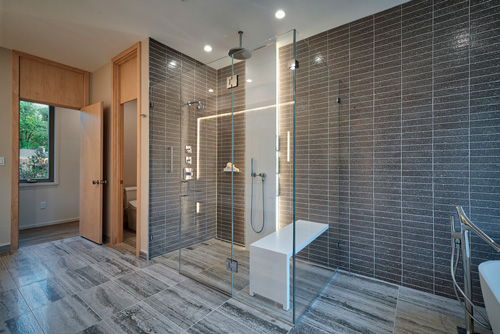In the realm of bathroom design, the shower holds a place of paramount importance. It’s not just a functional fixture; it’s a sanctuary of relaxation and rejuvenation. Crafting the perfect shower space requires a delicate balance of form and function. In this article, we’ll delve into the essential tips to help you design the ideal shower that seamlessly blends aesthetics, practicality, and your personal style.
Understanding Your Needs and Space
Start by understanding your needs and space. Consider your daily shower routine: quick and invigorating or long and luxurious? Assess if there are specific needs for family members, like accessibility. Examine your budget and space. Is it a compact bathroom requiring space-saving solutions, or do you have ample room? Identify structural or plumbing constraints early to avoid issues later.
Choosing The Right Shower Design
The initial decision in your design journey revolves around the type of shower design that aligns with your needs and space. Here are some popular options to ponder:
- Walk-In Showers: These open, spacious designs offer a contemporary feel and accessibility. They lend a sense of luxury, especially in larger bathrooms.
- Alcove Showers: Alcove showers are enclosed on three sides by walls, making them a space-saving choice for smaller bathrooms. They often feature sliding doors for accessibility.
- Corner Showers: For those aiming to maximize space in compact bathrooms, corner showers fit snugly into corners. They come in various configurations, such as neo-angle or square.
The shower door style, whether it’s frameless, semi-frameless, sliding, pivot, or hinged, plays a crucial role in both aesthetics and functionality. Consider your preference for a shower head – whether you prefer the soothing sensation of a rainfall showerhead or the versatility of a handheld one. Ensure your choice complements both functionality and your overall design vision.
Nailing The Layout and Placement
Creating the ideal shower layout is vital for both form and function. Consider plumbing access, natural light, and traffic flow. The goal is a space-efficient, comfortable design. Also, ensure proper water flow and drainage with a well-designed system to prevent water accumulation, enhancing safety and durability.

Material Selection for Walls and Floors
Selecting the right materials for your shower’s walls and floors is a pivotal decision. Durability and water resistance take precedence. Here are some commonly favored options:
- Tile: Ceramic or porcelain tiles are timeless choices, available in a plethora of colors and styles. They are easy to clean and maintain, making them an ideal fit for shower spaces.
- Natural Stone: Materials like marble, granite, and travertine exude a luxurious and sophisticated aura. However, they require more care to prevent staining and deterioration.
- Acrylic or Fiberglass: These materials are lightweight, cost-effective, and straightforward to install. They are renowned for their water resistance.
It’s imperative that the materials you choose for both walls and floors coalesce seamlessly, creating a unified and aesthetically pleasing shower space.
Incorporating Storage Solutions
An organized shower space hinges on effective storage solutions. Built-in niches, strategically placed corner shelves, and thoughtfully positioned towel bars and hooks can keep shower essentials within easy reach and tidy. Strike a balance between storage functionality and design aesthetics to achieve harmony.
Proper Ventilation and Lighting
Proper ventilation is your ally in combating mold and humidity issues in the bathroom. An exhaust fan or strategically placed windows can aid in efficient air circulation. Lighting, on the other hand, comes in two dimensions: task and ambient. Task lighting near the shower area ensures visibility for showering and grooming, while ambient lighting sets the overall bathroom mood.
Adding Personal Touches
To infuse your shower with a unique personality, consider personal touches. Incorporate design elements like mosaic tiles or patterns that mirror your style. Opt for a color scheme that resonates with your vision and complements the broader bathroom design. For a final flourish, introduce decorative elements such as plants, artwork, or accent tiles to breathe life into your shower space.
Ensuring Accessibility and Safety
For some individuals, accessibility is paramount in shower design. Universal design principles that cater to individuals of all abilities should be considered. Install grab bars at strategic points for safety and opt for non-slip surfaces for shower floors. Adherence to building codes and regulations concerning shower accessibility and safety is imperative.
Water Efficiency and Eco-Friendly Options
In today’s eco-conscious world, eco-friendly choices and water efficiency are vital considerations. Low-flow showerheads and faucets can significantly reduce water consumption while ensuring a satisfying shower experience. Simultaneously, choose eco-friendly materials and finishes with a reduced environmental footprint.
Maintenance And Cleaning Tips
To keep your shower space in pristine condition, adopt a regular maintenance regimen. Routine cleaning helps prevent mold and mildew buildup. Vigilance towards fixtures and grout ensures they remain in top-notch condition. A long-term care strategy will safeguard both the beauty and functionality of your shower for years to come.
Design Your Dream Shower with River Glass Designs
Crafting the ideal shower is a blend of form and function. By thoughtfully evaluating your requirements and choosing the right design elements and materials, you can enhance your daily routine and add value to your bathroom.
Don’t forget to factor in accessibility, safety, and eco-conscious decisions in modern design. Armed with these key insights, you’re prepared to create the perfect shower space tailored to your unique preferences and needs. For expert guidance, reach out to River Glass Designs today.

